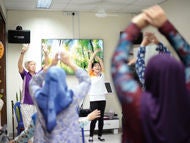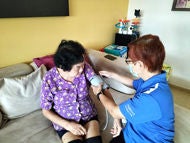What is - Achondroplasia
What is achondroplasia?
Achondroplasia is the most common type of short-limb short stature. It is a genetic disorder that affects bone growth.
Individuals with achondroplasia have disproportionate short stature and certain characteristic features. Intellect is typically normal.
How common is achondroplasia?
It is estimated that one in 22,000 people are born with achondroplasia. Occurrences of achondroplasia are present among all racial groups and affects both males and females equally.
Symptoms of Achondroplasia
What are the features of achondroplasia?
Achondroplasia is a condition one is born with. It can sometimes be diagnosed before birth by antenatal ultrasound scans in the third trimester.
The severity of symptoms may vary from person to person, even among family members with achondroplasia.
The main features include:
- Short stature: The average adult height is approximately 120-135 cm
- Facial features: Larger head size with a prominent forehead and flattened nose bridge
- Rhizomelic shortening: Short extremities with shortened bones in upper arms and thighs
- Limited elbow extension: Inability to fully straighten elbows
- Short fingers with trident appearance of hands and short toes: Short fingers with increased space between the third and fourth fingers
- Bow legs: Outward curving of the bones between the thighs and ankles
- Kyphosis: Curving of the upper spine due to reduced muscle tone, typically in infancy and which improves once the child begins walking
- Lumbar lordosis: Curving of the lower spine which commonly develops after the child starts walking
What are some other medical concerns associated with achondroplasia?
The following issues can also be present in individuals with achondroplasia and need to be monitored for and treated if present:
- Craniocervical junction constriction: Narrowing of the junction between the skull and neck spinal bone
- Spinal stenosis: Due to small vertebral canals (spaces inside the spinal bones) leading to spinal cord compression
- Hydrocephalus: Build-up of fluid in the brain
- Regular ear infections due to middle ear dysfunction
- Obstructive sleep apnoea: No breathing for short periods of time when asleep
- Restrictive pulmonary disease: Due to small chest causing smaller lung volumes
- Obesity
- Dental problems
Achondroplasia - Causes and Risk Factors
What causes achondroplasia?
Genes are instructions for cells to make proteins in the body. Achondroplasia is the result of a pathogenic (disease-causing) change in the FGFR3 gene located on chromosome 4.
This gene provides instructions for a protein that is important for bone growth. When there is a pathogenic change in the FGFR3 gene, the protein is affected and bone development is impacted.
This causes affected individuals to be short, with shortened upper limbs, hands and feet. Bones in the spine and legs are also at risk of curving.
How is achondroplasia inherited?
Everyone carries two copies of each gene, one inherited from each parent.
Achondroplasia follows a dominant inheritance pattern, which means that a pathogenic change in one copy of the FGFR3 gene can cause achondroplasia. If one parent has achondroplasia, a child has a 50% chance of inheriting the disease.
About 80% of people with achondroplasia have parents who are of average height, while the remaining 20% have at least one parent who has achondroplasia.
Diagnosis of Achondroplasia
How is achondroplasia diagnosed?
Achondroplasia is diagnosed following a comprehensive evaluation by a healthcare professional with expertise in skeletal dysplasias. The diagnostic process includes a detailed clinical assessment, radiological imaging and, , genetic testing.
- Clinical evaluation: A specialist will conduct a thorough physical examination to assess characteristic features of achondroplasia. These include disproportionate short stature, shortened upper limbs, a prominent forehead and spinal curvature. The presence of joint hypermobility and ligament laxity may also be evaluated for.
- Radiological assessment: X-rays are performed to examine skeletal abnormalities, which can include shortened long bones and specific changes in the shape of the pelvis, skull and vertebrae.
- Genetic testing: Genetic testing can be performed to identify pathogenic (disease-causing) variants in the FGFR3 gene.
Treatment for Achondroplasia
Can achondroplasia be cured?
Voxzogo (vosoritide) is a drug approved for the treatment of children with achondroplasia.. It has been shown to improve annual growth rate in children with achondroplasia and promote proportional growth.
How is achondroplasia managed?
The multidisciplinary medical team looking after your child will be able to address specific medical concerns and related health issues.
Below are some related medical issues and how they can be managed:
| Medical issue | Treatment |
|---|---|
| Middle ear dysfunction |
|
| Obstructive sleep apnoea and/or restrictive pulmonary disease |
|
| Kyphosis and spinal stenosis |
|
| Hydrocephalus |
|
| Craniocervical junction constriction |
|
| Obesity |
|
FAQs on Achondroplasia
In 80% of cases, achondroplasia is the result of a spontaneous change in the genetic material of the sperm or egg at conception, in families with no previous history of the condition.
People with achondroplasia typically have a normal life expectancy. However, they may face complications that require ongoing medical care, such as spinal stenosis, hydrocephalus and orthopaedic issues. With proper treatment and care, individuals with achondroplasia can lead active and fulfilling lives.
Achondroplasia - Other Information
Achondroplasia is a lifelong condition. Should you require financial assistance or emotional support, please approach your doctor for referral to a medical social worker.
| Support Group |
|---|
Little People of America |
MAGIC Foundation |
Club Rainbow Singapore |
Download the Achondroplasia brochure.
References
Achondroplasia - orthoinfo -AAOS. OrthoInfo. (n.d.). https://orthoinfo.aaos.org/en/diseases--conditions/achondroplasia/
Anzilotti, A. W. (Ed.). (2022, April). Achondroplasia (for parents) | nemours kidshealth. KidsHealth. https://kidshealth.org/en/parents/achondroplasia.html
Contributed by
The information provided is not intended as medical advice. Terms of use. Information provided by SingHealth.
Get to know our doctors at SingHealth Hospitals in Singapore.
Get to know our doctors at SingHealth Hospitals in Singapore. here.





















